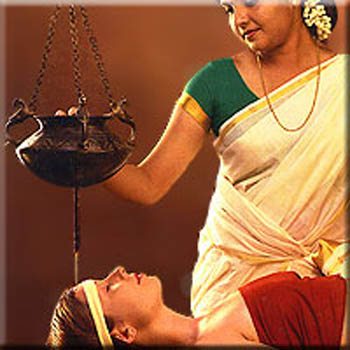
Ayurveda Takes Root in America
Will students be heading to American universities to get their degrees as Ayurvedic doctors? Will patients seek out practitioners of this 5000 year old system of medicine from India when next they have health problems? And will Ayurveda form the basis for new health and beauty products, even of restaurant menus, in the US?
Highly unlikely, you say.
Well, remember yoga? This once equally obscure ancient practice from India is hardly considered Indian anymore and has gone global. Now there’s a yoga studio in practically every mall across America! Everyone from the waitress in the fast food place to seniors in the local Y does yoga. In fact, yoga has been embraced to such an extent that there are now American versions from chair yoga to baby yoga to even doga – yoga for dogs!
As the world turns ever more complex, people yearn more for the natural and the organic, the simple and the pure. Ayurvedic practitioners are gradually taking root in the US, and Ayurveda is entering the lexicon in everything from spas to restaurants to supplements and cosmetics.
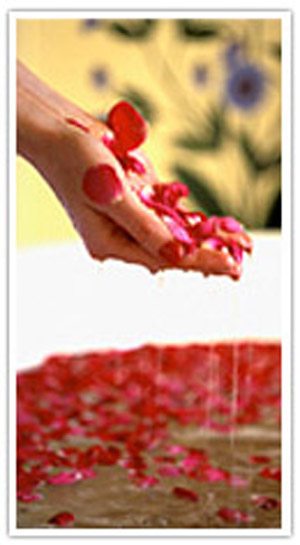
Ayurvedic Spas and Treatments
Yes, Ayurveda’s name is being heard more often, with many of the Western spas providing Ayurvedic massage and treatments, the most noted being Deepak Chopra’s Chopra Center for Wellness in New York and CA. There’s Pratima Skincare and Spa in New York, founded by Dr. Pratima Raichur who has written ‘Absolute Beauty’, a book on skincare based on Ayurveda, and who also offers a whole line of Ayurvedic beauty products.
Indeed, products which are based on Ayurvedic formulations are increasing in the US, and include Shahnaaz Husain’s herbal products which are well-known both in India and the US. The latest to join the Ayurveda Gold Rush is an Italian-American, Laura Callegari, who has created the Bhaktiveda products which range from Tulsi body lotion to Neem hand cream to Indian-rose scented bath salts.
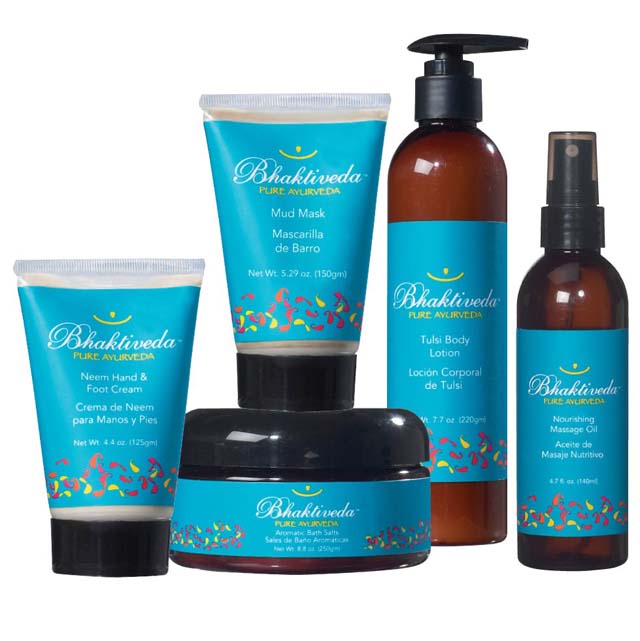
While Ayurveda is not as visible as yoga, it’s certainly gaining ground in America. The irony is that while many mainstream Americans are more adventurous and open to the principles of this healing system, Indian-Americans generally are reluctant to accept this indigenous form of medicine, even though they still practice many of the home cures which have their basis in Ayurveda.
“I have hardly any Indian patients,” says Pratibha Shah, an Ayurveda practitioner in Philadelphia, who is the secretary of Association of Ayurvedic Professionals of North America (AAPNA.) “Is there a demand for Ayurveda? Yes, absolutely there is a demand, but the clients are primarily Americans because the Indians who come here are still not oriented toward their own traditions – I have not seen that yet.”
AAPNA is holding an international conference in Miami, Florida in October which will perhaps answer many of the questions people have about Ayurveda viability in the US. The keynote speaker is Ricky Williams, Running Back for the Dolphins and an avid Ayurveda student. The theme of the 3 day conference is ‘Anti-Aging and Rejuvenation through Ayurveda.’
Indeed, Ayurveda has a past history in America and over the years, it has been winning converts as a part of complementary medicine, along with other natural and holistic traditions including acupuncture, massage therapy and Reiki healing. Some major hospitals which are devoted to allopathy are now introducing Integrative Medicine, which includes many of these disciplines.
The Mayo Clinic, as well as the Memorial Sloan-Kettering Hospital, have sizable Integrative Centers which offer everything from Yoga to music therapy to acupuncture and Reiki along with allopathy. Neither offers Ayurveda though Memorial Sloan-Kettering’s Integrative Center does provide an online list of hundreds of herbs and their compatibility with cancer treatment drugs.

Ayurveda’s History
To introduce Ayurveda and showcase Ayurvedic massage, supplements and beauty products to the mainstream, the Indian Consulate in New York organized a conference with Ayurvedic experts and vendors from India and the U.S. One of the speakers was Dr. Scott Gerson, who holds degrees in both Ayurveda and allopathic medicine, and established the National Institute of Ayurvedic Medicine (NIAM) in the US in 1982.
Having been on both sides of the medical divide, he described the single most important difference between eastern and western medicine. “We view all people as a dynamic flow of energy and it is this underlying energetic matrix that crystallizes into the physical body,” he said, explaining the dynamics behind Ayurveda. In Western treatments, however, he said, doctors look instead to label people, they want the name of the disease because without that they cannot prescribe a course of action which will suppress the pathological process.
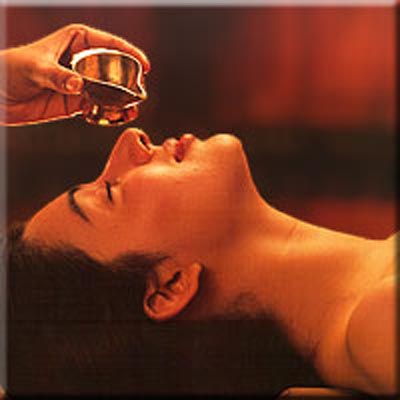
He added, “In Ayurveda, we ask a completely different set of questions, and I believe, a more accurate, more human set of questions. We ask what is the energetic state of this person and is this person in balance? Where this imbalance in this person’s mind and body, and is that causing an obstruction in the energy, the life force which is the key to all health and disease?”
He explained that whereas Ayurveda takes time, in a very real sense it is timeless, and you capture your tension in the very moment you’re preparing tea in the morning or the oil for your massage. He advised, “Find some entrée into Ayurveda, whether it’s the massage or the herbal medicines, or the yoga exercises which will open up a whole new world for you.”
Yet Ayurveda continues to remain on the periphery for, unlike in India, where it is recognized as a medical system, here Ayurvedic practitioners are not licensed. Dr. Amala Guha, Professor of Immunology and Medicine Director, Complementary Alternative Support Care (CASE) at the University Of Connecticut School Of Medicine, is one of the Ayurvedic experts who is working to get this ancient science educational credit in this country.
The University offers Understanding Ayurveda, an introductory Ayurveda course to first and second year medical students, as well as advanced credit courses for which the students also get to travel to India.
Guha, who is the President of the International Society for Ayurveda and Health, is also the editor of Elements, a journal for alternative medicine. Her expertise in cancer immunology is combined with training in Ayurveda, and she is a reviewer for the National Center for Complementary and Alternative Medicine, which is a branch of the National Institutes of Health (NIH)
She looks with an unbiased eye at some of the hurdles Ayurveda faces in this country: “It’s very difficult, as the credibility of practitioners is being questioned. Another challenge we face is supplements are not known as therapeutic or health models and being free from scrutiny, there’s no quality control. Many of them are adulterated with heavy metals. After taking them, people sometimes land up in our emergency rooms. We cannot deny that these things are happening. In NY itself three herbal supplements were banned.”
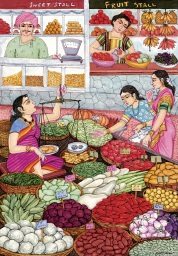
How different is the situation in the US, as compared to India? We asked Prathiba Shah, an Ayurvedic expert who practiced Ayurveda in Delhi for 12 years before moving to the US and taking on the same profession in Philadelphia. She was the Chief Medical Officer in the Central Government Health Scheme in Delhi. It had outpatient departments with its own pharmacies which offered allopathy, homeopathy, Ayurveda, and Unani medicine all in one place. She says, “So the patients have a choice of different treatment modalities under one roof.”
Whereas under British rule, Ayurveda and other traditional forms of medicine were looked down upon in India, things are quite different now with all the traditional forms being integrated into the mainstream healthcare of the country. As Shah points out, Ayurveda is gaining popularity because it lacks drug side-effects and is a holistic system where the body is treated as an entity, and the approach is to find out the root cause of a problem and make the whole system healthy.
In India, Ayurveda has been incorporated into governmental health facilities as well as many institutions like Max Health Care which has centers all over India, as well as other private health centers in North and South which offer both western and eastern medicine and the option to choose the form of treatment.
So why has the same not happened in the US?
Here the practice of Ayurveda is not licensed – and that’s a major stumbling block. Most health plans would not reimburse the costs of Ayurvedic treatments – and there is also the credibility question with patients. If something is not licensed by the government, how much can they trust it?
Still, Ayurveda is being practiced widely in the US at different levels, from Panchakarma, which is the high level of Ayurveda, to basically lifestyle consultations, supplement support and diet charts. Although Ayurveda is not licensed, it can be practiced in a limited form due to the Freedom of Health Act which exists in various states.
With a good Ayurvedic practitioner on your side, you can at least get your bearings, and learn to control your own health issues. Pratibha Shah, for instance, has reared her family totally on Ayurveda. “Though we have a PCP – personal care physician – and go for routine physical exams every year, we’ve never had to visit any doctor for health issues in the past six years.”
Of course, if one has major illnesses or a life-threatening situation, then one should opt for mainstream medicine. Shah says, “What I strongly emphasize is that the preventative health care that is in Ayurveda, no other system of medicine can match up to that. The first line of treatment if someone has a problem is to make changes in lifestyle, in diet and if you can get someone to determine your body type, have a diet chart and according to that make sure you’re eating right.”
Ayurveda’s Future
Indeed, it’s the integrated approach both patients and providers need to keep in mind. Shah also likes to point out that allopathy has life saving capabilities but more than allopathy these are advancements of technology. “If you have an MRI, its technology that’s you’re using, not a system of medicine,” she says. “MRI can be used by an Ayurvedic physician also. Laser treatment for gallstones is not allopathy – its technology; I’m not against that but once you know you have a gallstone you can start avoiding fatty fried food which forms gallstones. So that’s the kind of approach that should be taken.”
As with everything Indian, the opportunities to listen to Ayurvedic speakers, try remedies and treatments and just learn more about this ancient system are increasing, especially in certain states like California and New York. AAPNA has announced Ayurveda Day in October, to coincide with the birth celebrations of Lord Dhanwantari, the creator of Ayurveda. On Ayurveda Day, free Ayurveda awareness lectures, workshops, and other special events will be conducted in various American cities.
Travel to India is also familiarizing many Americans and second-generation Indian Americans with the benefits of Ayurveda, its treatments, massages and products. Since tourists go to India specifically for Kerala’s famous massage treatments, it seems a smart move to bring those treatments to the US. Santhigram Kerala Ayurvedic Co, a Kerala style Ayurvedic wellness center which has branches in India, now has four centers in New Jersey to offer the traditional Kerala Panchakarma therapy. A fifth center is scheduled to open in Houston, Texas.
According to Gopinathan Nair, CEO of Santhigram, “Our specialized Ayurvedic and Panchakarma therapies help alleviate specific problems like back and neck pain, frozen shoulder, migraine, insomnia and joint pain, besides revitalizing the body.” Having targeted the Indian areas of New Jersey, Nair says 70 percent of the clients are Indians but Ayurveda is getting popular with Americans too. He says, “In fact, the latest center is in Denville where the white population is more and we started getting these clients from Day 1.”
At the opening of the center in Denville, noted business leader Sreedhar Menon vouched for the power of Ayurvedic therapy, describing how it had helped him avoid knee transplant surgery. At this event, NJ State Assemblyman Upendra Chivukula said he would make efforts for legislation supportive of Ayurvedic medicine in New Jersey, as is being done in California.
More and more, trained talent from India seems to be coming to the US. Ambika Nair, who was the personal physician to the former president of India, K.R. Narayanan, is now with Santhigram, along with other Ayurvedic practitioners.
Ayurvedic supplements are big business in the US but there are often concerns about what goes into those bottles. One manufacturer who has met that challenge is Uday Gupta of American Ayurveda- he simply manufactures the products right here in the US. “We found that most of the products from India do not meet the FDA guidelines on the content of heavy metals, and this way we also have quality control,” says Gupta. “Most of the ingredients are from California, though we get those which are unavailable here from India.”
Asked as to who the clients are for products ranging from Blood Cleaner Capsules and Regularity Capsules to herbal teas and oils, Gupta says, “Both Indians and Americans. Interestingly, we find that most of our clients are healthcare professionals, including physicians practicing mainstream medicine.”
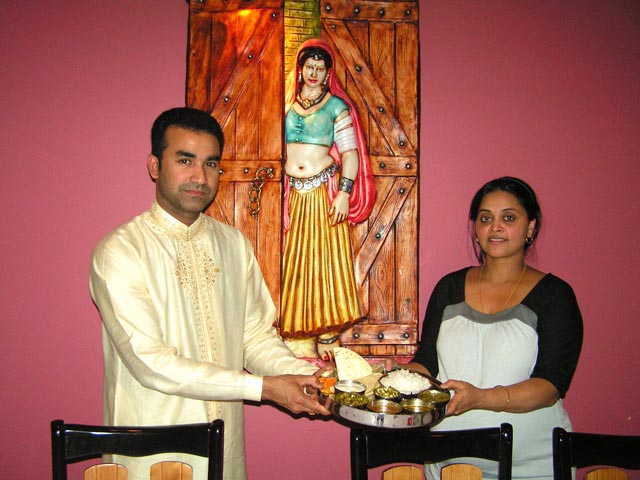
Ayurveda’s Meals
Walking in New York’s Curry Hill area, you see Yogi’s Kitchen, a brand new eatery devoted to serving food cooked purely according to Ayurvedic principles, and served in steel thalis. It’s such a guilt-free space it doesn’t even have a deep fryer! ”Even our papads are roasted,” says Mamta Mulloi, who owns this little restaurant in Manhattan with her husband Dinu. “We don’t do a la carte because in that people will order only one dish – and that will not have all the elements to make it a balanced meal.”
In Ayurvedic meals it’s important to have balance with all the five vital elements being present. Spiritual Awakening South Thali gives you a complete gastronomical experience of a balanced, lightweight and yet savory meal consisting of rice, roti, sambar, rasam, pulikulambli, poriyal, avial, and kootu, while the Spiritual Awakening North Thali substitutes the main dishes with dal, kadhi and two vegetables. Both thalis include yogurt and sprout salad as the protein source, and also include papads and dessert.
The Mullois hope to educate their consumers, and plans are on to have a small library of Ayurvedic books on hand, as well as Ayurvedic information. They point out that the spices in the food aid digestion and strengthen the immune system. The black pepper in the rasam is great for preventing colds and throat infections and the garlic in the food lowers cholesterol, inhibits rheumatism besides having anti-cancer and anti-bacterial properties. Many of the dishes have turmeric, that wonder spice which is reputed to be a natural blood-purifier and improves liver function, skin tone and is an antiseptic.
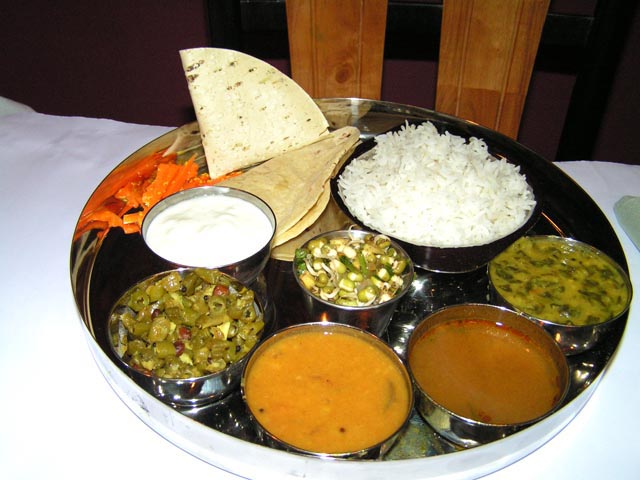
Yes, in bits and pieces Ayurveda is certainly entering our lives. As the mainstream spas offering Ayurvedic massages and treatments increase, the tongue-twisting word ‘Ayurveda’ becomes easier to handle for many Americans. Applying a slather of these soothing herbal products to one’s hands or soaking in a warm bath suffused with sandalwood or jasmine, one cannot but feel that with such a start, the day is already off to a positive start.
We can take as much as we want, or as little as we want, from dosha consultations to diet changes to organic toiletries to oil massages. We can start with small steps, right in our kitchen, investigating the potent health cures in the Indian spice box.
Ayurveda is all about balance, and don’t we all yearn for that in our busy, over-scheduled lives?
(c) Lavina Melwani
(This article first appeared in Khabar magazine)

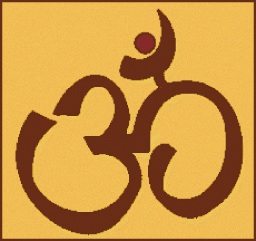
7 Comments
May I use some of your images on my brochure to enhance the awareness of ayurvedic therapies?pls let me know
There is no classical reference for cooking in Ayurveda, why are you people spoiling its name?
Please send me details of eye care treatment in Ayurveda for poor vision due to retina problems.
Pingback: Is Ayurveda the Next Yoga? | The Chakra News
Ashok, while the mainstream may be distancing Yoga or Ayurveda from Hinduism, I seem to have done it unintentionally – knowing Ayurveda to be an integral part of Hinduism I did not even go into that aspect as this piece was about Ayurveda’s inroads into America.
Thanks for pointing out this blooper to me – I will certainly rectify it, and add in details for readers who may not realize this connection.
The words Hinduism or Hindu don’t appear at all in this whole article. Like Yoga, Ayurveda’s origins is the Hindu culture. Taking it out of its heritage dilutes the system no end.
Pingback: Hinduism Today Magazine - Hindu Press International » Is Ayurveda the Next Yoga?